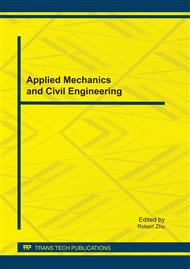[1]
H.B. Sutherland, M.S. Mesdary, The influence of the intermediate principal stress on the strength of sand, Proceedings of 7th International Conference on Soil Mechanics and Foundation Engineering, Mexico City, 1 (1969) 391-399.
Google Scholar
[2]
K. Mogi, Effect of the triaxial stress system on the failure of dolomite and limestone, Tectonophysics. 11(2) (1971) 111-127.
DOI: 10.1016/0040-1951(71)90059-x
Google Scholar
[3]
D.H. Cornforth, Some experiments on the influence of strain conditions on the strength of sand, Geotechnique. 14 (2) (1964) 143-167.
DOI: 10.1680/geot.1964.14.2.143
Google Scholar
[4]
O.C. Zienkiewicz, G.N. Pande, Some useful forms of isotropic yield surfaces for soil and rock mechanics, In: Gudehus G, editor. Finite elements in geomechanics. Wiley, 1977, pp.179-190.
Google Scholar
[5]
P.V. Lade, J.M. Duncan, Elastoplastic stress-strain theory for cohesionless soil, Journal of Geotechnical Engineering Division ASCE. 101(10) (1975) 1037-1053.
DOI: 10.1061/ajgeb6.0000204
Google Scholar
[6]
H. Matsuoka, T. Nakai, Stress deformation and strength characteristics of soil under three difference principal stress, Proc JSCE. 232 (1974) 59-70.
DOI: 10.2208/jscej1969.1974.232_59
Google Scholar
[7]
M.H. Yu, Unified strength theory and its applications. Berlin: Springer, 2004.
Google Scholar
[8]
ITASCA Consulting Group, FLAC—Fast Lagrangian Analysis of Continua, version 5.0, user's manual. Minneapolis: Itasca Consulting Group, Inc, 2005.
Google Scholar
[9]
J.M. Duncan, State of the art: Limit equilibrium and finite-element analysis of slopes, Journal of Geotechnical Engineering ASCE. 122(7) (1996) 577-596.
DOI: 10.1061/(asce)0733-9410(1996)122:7(577)
Google Scholar
[10]
O.C. Zienkiewicz, C. Humpheson. R.W. Lewis, Associated and non-associated visco-plasticity and plasticity in soil mechanics, Geotechnique. 25(4) (1975) 671-689.
DOI: 10.1680/geot.1975.25.4.671
Google Scholar
[11]
O,C, Zienkiewicz, The Finite Element Method and the Solution of Some Geophysical Problems, Philosophical Transactions of the Royal Society of London Series a-Mathematical Physical and Engineering Sciences. 283(1312) (1976) 139-151.
DOI: 10.1098/rsta.1976.0074
Google Scholar
[12]
D.V. Griffiths, P.A. Lane, Slope stability analysis by finite elements, Geotechnique, 49(3) (1999) 387-403.
Google Scholar
[13]
A.W. Bishop, N.R. Morgenstern, Stability coefficients for earth slopes, Geotechnique. 10 (1960) 129-150.
Google Scholar
[14]
C.C. Swan, Y.K. Seo, Limit state analysis of earthen slopes using dual continuum/FEM approaches, International Journal of Numerical Analysis Method in Geotechnical. 23 (1999) 1359-1371.
DOI: 10.1002/(sici)1096-9853(199910)23:12<1359::aid-nag39>3.0.co;2-y
Google Scholar
[15]
Y.M. Cheng, T. Lansivaara, W.B. Wei, Two-dimensional slope stability analysis by limit equilibrium and strength reduction methods, Computers and Geotechnics. 34 (2007) 137-150.
DOI: 10.1016/j.compgeo.2006.10.011
Google Scholar


